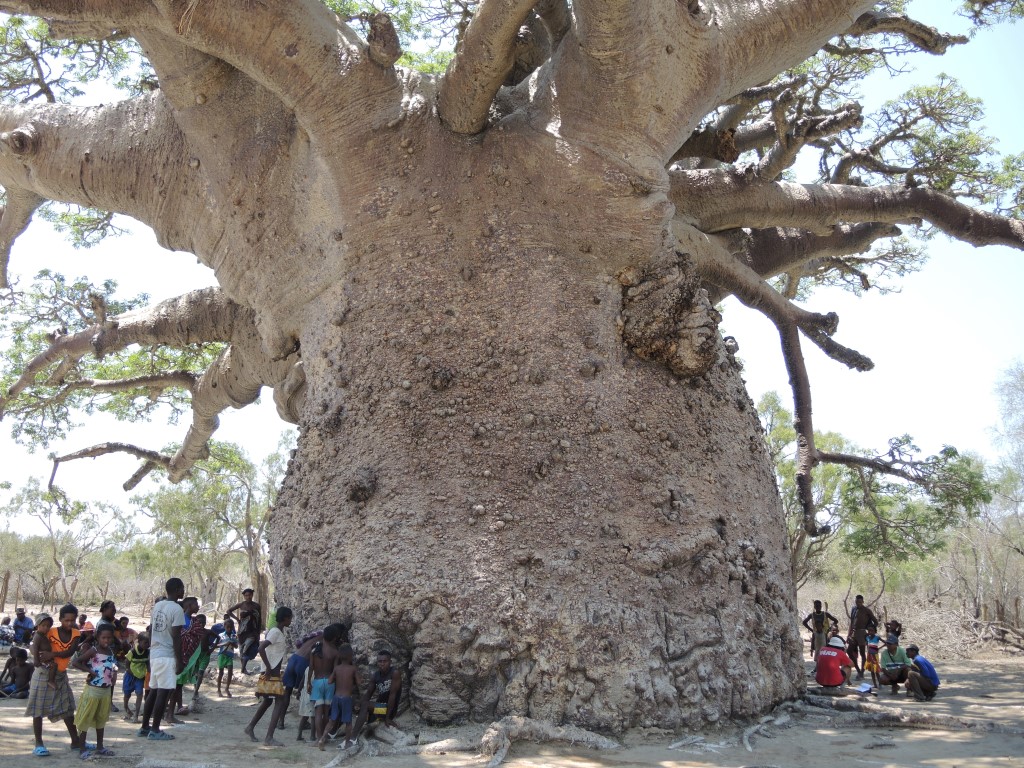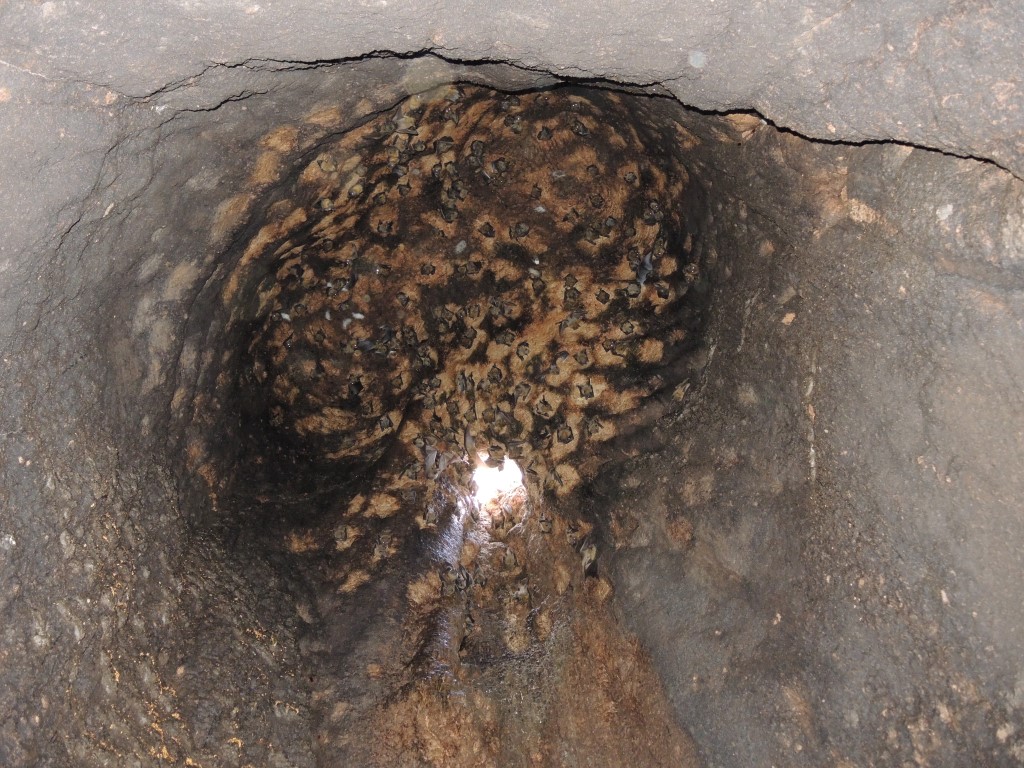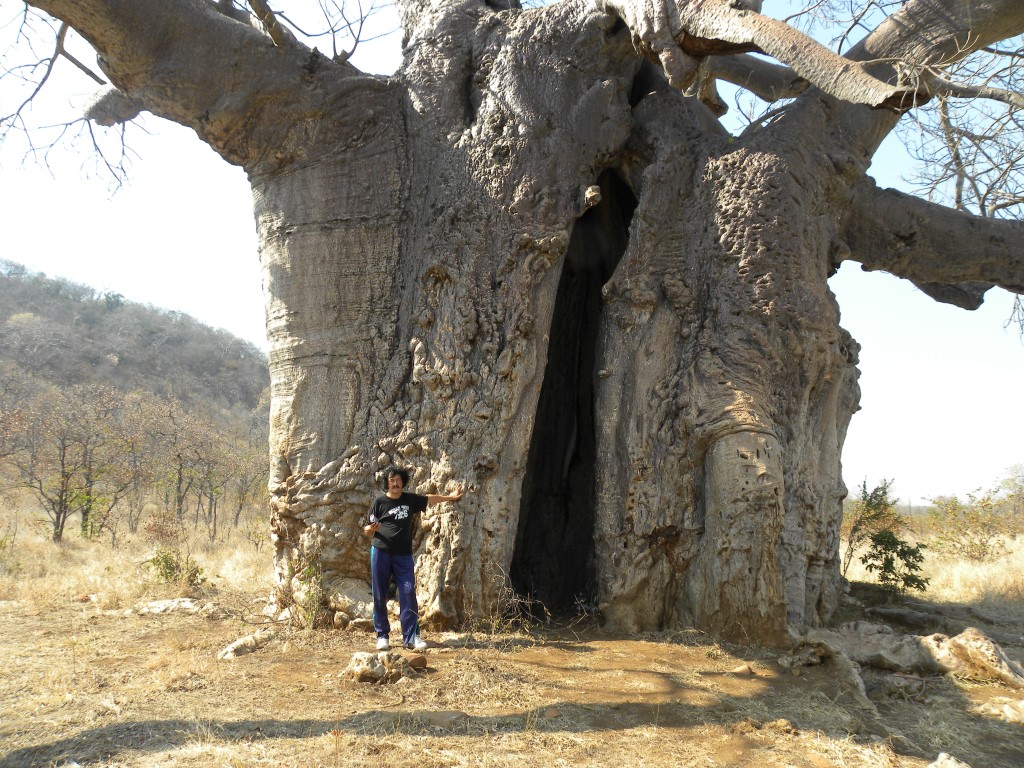



Poster presentation
Radiocarbon dating of African baobabs (Adansonia digitata)
with ring-shaped structures and false inner cavities
Roxana T. Patrut1, Karl F. von Reden2, Stephan Woodborne3,
Laszlo Rakosy1, Adrian Patrut4, Grant Hall5, Sébastien Garnaud6,
Daniel A. Lowy7, Dragos Margineanu4
1Babeş-Bolyai University, Faculty of Biology and Geology, Cluj-Napoca, Romania.
2NOSAMS Facility, Dept. of Geology & Geophysics, Woods Hole Oceanographic Institution, Woods Hole, MA, U.S.A.
3iThemba Laboratories, Somerset West, 7129, South Africa.
4Babeş-Bolyai University, Faculty of Chemistry, Cluj-Napoca, Romania.
5Mammal Research Institute, University of Pretoria, South Africa.
6INECOBA, 93600 Aulnay-sous-Bois, France.
7Nova University, Alexandria Campus, Alexandria, VA, U.S.A.
Abstract
Several chronological anomalies were observed for the first time in the radiocarbon investigation of wood samples collected from the large inner cavity and from the outer part of an old African baobab (Adansonia digitata L.), i.e., the Lebombo Eco Trail tree (Mozambique). According to AMS dating results, the age values of all samples increase from the sampling point with the distance into the wood. For samples collected from the cavity walls, the increase of age values with the distance into the wood (up to a point of maximum age) represents a major anomaly and contradicts previous interpretations of the structure of trees. The only realistic explanation for this anomaly is that such inner cavities are, in fact, natural empty spaces between several fused stems which are disposed in a ring-shaped structure. We named them false cavities. Subsequently, we found and dated other African baobabs with ring-shaped structures and false inner cavities. We found that this new baobab architecture enables African baobabs to reach large sizes and old ages.
Here we present the AMS dating results of three large African baobabs, namely Holboom (Nyae Nyae Conservancy, Namibia), Luna tree (Mapungubwe National Park, South Africa) and the baobab of Samba Dia (Senegal). The age sequences of samples collected from all these individuals show the characteristic anomalies of baobabs with false inner cavities. According to radiocarbon dating results, the 3 investigated baobabs are multi-stemmed; their trunks consist of fused stems belonging to several generations. Each individual also has typical features, which offer new data on the progressive formation of ring-shaped structures with false inner cavities.
The oldest dated sample originates from Holboom, which has the stoutest trunk of all baobabs (circumference at 1.30 m: 35.10 m); its radiocarbon date of 1760 ± 18 BP corresponds to a calibrated age of 1735 ± 25 years. Holboom has a double closed ring-shaped structure, which consists of six fused stems that close two connected false cavities; it also possess two „arms”, which are additional stems outside the rings. The biggest stem broke off in 2012, as well as some walls of the largest cavity. Unfortunately, Holboom, which is currently the oldest live African baobab with accurate dating results, is dying and will collapse over the next years.
The oldest sample of the Luna tree has a radiocarbon date of 1507 ± 22 BP, which corresponds to a calibrated age of 1405 ± 25 years. The Luna tree exhibits a ring-shaped structure with two rings and two connected false cavities defined by six stems. Our results also show that the Luna tree stopped growing over the past 500-600 years. The Senegalese baobab of Samba Dia, which has the largest known false cavity (18 m2, 70 m3) was found to be younger and has an age close to 500 years. Despite its large dimensions, it continues to grow at almost constant rate.
Our research demonstrates that ring-shaped structures with false cavities are common features of individuals belonging to Adansonia digitata that achieve large dimensions and old ages.
The AMS radiocarbon investigations were performed at the NOSAMS Facility of the Woods Hole Oceanographic Institution.
The research was funded by the Romanian Ministry of National Education CNCS-UEFISCDI under grant PN-II-ID-PCE-2013-76.
Poster presentation
The growth stop phenomenon of baobabs (Adansonia spp.)
identified by AMS radiocarbon dating
Adrian Patrut1,*, Stephan Woodborne2, Karl F. von Reden3,
Grant Hall4, Roxana T. Patrut5, Laszlo Rakosy5, Pascal Danthu6,7,
Jean-Michel Leong Pock-Tsy7, Daniel A. Lowy8, Dragos Margineanu1
1Babeş-Bolyai University, Faculty of Chemistry, Cluj-Napoca, Romania.
2iThemba Laboratories, Somerset West, 7129, South Africa.
3NOSAMS Facility, Dept. of Geology & Geophysics, Woods Hole Oceanographic Institution, Woods Hole, MA, U.S.A.
4Mammal Research Institute, University of Pretoria, South Africa.
5Babeş-Bolyai University, Faculty of Biology and Geology, Cluj-Napoca, Romania.
6DP Forêt et Biodiversité, Antananarivo, Madagascar.
7Cirad, UPR BSEF, Montpellier, France.
8Nova University, Alexandria Campus, Alexandria, VA, U.S.A.
*apatrut@gmail.com
In 2005, we started an in-depth research program to elucidate several controversial or poorly understood aspects regarding the architecture, growth and age of the African baobab (Adansonia digitata). The research is based on our new approach which allows to investigate and date standing and live specimens. This methodology consists of AMS radiocarbon dating of small wood samples collected especially from inner cavities, but also from deep incisions/entrances in the stems and from the outer part of large baobabs.
The existence of growth rings in African baobabs has generated much controversy. We used AMS radiocarbon dating to determine age sequences along wood samples collected from large and old African baobabs, which were compared against growth ring counts. The results demonstrate that African baobabs produce observable growth rings which correspond, with some notable exceptions, to one rainy season, namely to one year in the investigated regions. In certain cases, however, the outermost rings, that were practically adjacent to the bark, were found to be old, with ages of 150-800 years. Such results show that baobab stems may stop growing due to old age or to stress factors.
The first tree for which we identified the growth stop phenomenon was the Pafuri Outpost baobab.
The Pafuri Outpost baobab is located in the Pafuri Outpost area of Kruger National Park, Limpopo Province, South Africa (GPS coordinates 22º26.647' S, 031º04.745' E, altitude 200 m, annual rainfall 434 mm). Height 18.0 m, circumference at breast height (cbh; at 1.30 m above ground level), 14.20 m, overall wood volume 70 m3.
The Pafuri Outpost baobab (Fig. 1), one of the largest known single-stemmed African baobab, fell off and died in 2008. The inner part of the stem was still present and not decayed, so that it was possible to collect a sample for dating from the very first years of growth. The radiocarbon date of the pith was 1000 ± 20 bp, which corresponds to a calibrated age of 900 ± 25 yr (in 2008). We collected a large radial section with 434 growth rings from the collapsed stem. According to radiocarbon dating results the outermost rings were around 410 yr old. These results demonstrate that the trunk stopped completely growing in ad 1540, but the tree continued to live until ad 2008. We suspect that it stopped growing at a relatively young age for a baobab, due to the change of climate conditions during the Little Ice Age.
The vast majority of large and old African baobabs are multi-stemmed. For such trees, the growth may stop for the oldest stems, usually around the age of 1,000 yr. We exemplify our statement by presenting the growth stop for several old specimens: Lebombo Eco trail baobab, Dorslandboom and Chapman baobab.
The Lebombo Eco trail baobab is located in the Limpopo Transfrontalier Park, Mozambique (GPS coordinates 23º15.765' S, 031º33.309' E, altitude 290 m, annual rainfall 438 mm). Height 18.5 m, circumference at breast height 21.44 m, overall wood volume 220 m3.
The Lebombo Eco trail baobab (Fig. 2) was the first specimen for which we identified the most enigmatic baobab architecture, i.e., the closed ring-shaped stucture with a false cavity inside. According to AMS radiocarbon results, the ring is composed of 5 fused stems, that close a false cavity (Fig. 3). The radiocarbon date of the oldest sample, collected from the cavity walls, was 1425 ± 24 bp, which corresponds to a calibrated age of 1355 ± 15 yr. This value indicates that the oldest part of Lebombo Eco Trail baobab is 1400 ± 50 yr old. The dating results evince that the 5 stems exhibit different ages between 900 and 1400 years; The ring and the false cavity closed almost completely around 800–900 yr ago.
The dating results also show that the 5 stems of the Lebombo baobab continue growing at a quasi-constant rate toward the outer part. On the other hand, the innermost rings of the cavity samples, which are adjacent to the cavity bark, were found to be several hundred years old rather than being very young, as expected. This results demonstrate that the stems of the Lebombo baobab stopped completely growing toward the false cavity over the past 500 yr, for maintaining its stable internal architecture. However, the same stems continued growing at an almost constant rate toward the outer part.
Die Dorslandboom (The Thirstland tree) is positioned south of the Khaudum National Park, region Otjozondjupa, Namibia (GPS coordinates 19º18.061' S, 020º39.636' E, altitude 1132 m, annual rainfall 468 mm). Height 14.3 m, circumference at breast height over 25 m, overall wood volume 150 m3.
With its toppled or standing knitted stems, some of them broken and a few regenerated with new shoots, Dorslandboom (Figs. 4, 5) can be considered a kind of “Schrödinger’s baobab”, which is at the same time dead and alive. The largest stem (A) collapsed and died in 2006. Two stems (F and G) collapsed before 1880, but their remains are still alive, one leaning stem (E) is alive, while three stems (B, C and D) toppled, but new young branches grew at the ends of broken stems. The largest stem A consisted practically of two fused stems, so that Dorslandboom could be described more accurately as an eight-stemmed baobab. The structure of this “Phoenix tree” was completed recently by two very young stems (X and Y), which sprouted from roots.
The radiocarbon date of the oldest sample was 1957 ± 21 bp, which corresponds to a calibrated age of 1915 ± 30 yr (in 2006). This value makes the historic Dorslandboom to be the oldest known African baobab, with an estimated age of 2200 ± 100 yr. The outermost rings of the largest stem(s) were found to be over 800 yr old, showing that they stopped growing around ad 1200.
The Chapman baobab is situated close to Ntwetwe Pan of Makgadikgadi Pans, Central District, Botswana (GPS coordinates 20º29.404' S, 025º14.971' E, altitude 907 m, annual rainfall 360 mm). Height 22.6 m, circumference at breast height 25.90 m, overall wood volume 275 m3.
The historic Chapman baobab (Fig. 6) has an open ring-shaped structure and consists of 6 main stems, which are partially fused. According to AMS radiocarbon results, the 6 stems belong to 3 different generations, which are 1300, 1000 and 500 yr old. The oldest sample was collected from a decay cavity in the largest stem. Its radiocarbon date was 1277 ± 21 bp, which corresponds to a calibrated age of 1200 ± 75 yr. This result suggests an age of 1300 ± 100 yr for the oldest Chapman stem. The outermost rings are around 200 yr old, showing that this stem stopped growing around ad 1800. On the other hand, the other 5 stems continue their growth with a moderate rate.
In conclusion, we identified a new and unexpected phenomenon, which seems to be specific only to baobab trees: the growth stop. The growth stop may affect the entire tree or only its oldest stem(s). In this condition, the affected baobabs may survive for several centuries, by continuing to produce leaves, flowers and fruits,.
Acknowledgements.
The AMS radiocarbon investigations were performed at the NOSAMS Facility of the Woods Hole Oceanographic Institution.
The research was funded by the Romanian Ministry of National Education CNCS-UEFISCDI under grant PN-II-ID-PCE-2013-76.

Poster
presentation
Abstract published in the Programme and Abstracts Handbook of the 13th International Conference on Accelerator Mass Spectrometry at page 134
Topic:
General AMS Applications
Topic Code:
GAA
Structure and age of
the Grandidier’s baobab (Adansonia
grandidieri )
determined by AMS
radiocarbon dating
Adrian Patrut1, Karl von Reden2,
Jean-Michel Leong Pock-Tsy3, Laszlo Rakosy4, Roxana
Patrut4, Daniel Lowy5, Dragos Margineanu1,
Pascal Danthu3,6
1 Babeş-Bolyai University, Faculty of Chemistry, Cluj-Napoca, Romania.
2NOSAMS Facility, Dept. of Geology &
Geophysics, Woods Hole Oceanographic Institution,
Woods Hole, MA 02543, U.S.A.
3Cirad, DP Forêt et Biodiversité,
Antananarivo, Madagascar.
4Babeş-Bolyai University, Faculty of Biology and
Geology, Cluj-Napoca, Romania.
5Nova University, Alexandria Campus, Alexandria,
VA 22311-509, U.S.A.
6Cirad, UPR
BSEF, Montpellier, France.
The genus Adansonia
belonging to the Bombacoideae, a subfamily of Malvaceae, consists of nine
species. Six species are endemic to Madagascar and have a natural distribution
only here. The Grandidier’s baobab (Adansonia
grandidieri Baill.) is the biggest and most famous of the six Malagasy
baobab species.
Grandidier's baobab is classified
as endangered species by the IUCN Red List 2006. However, recent high-resolution
satellite images demonstrate that the total population of Grandidier’s baobab is much larger than
previous estimates, surpassing one million individuals.
The research presented here is the first
investigation of the architecture and age of the Grandidier’s baobab. Several
very large individuals from the Morombe-Andombiro-Andavadoaka area, including Tsitakakoike,
the largest Malagasy baobab, were examined; the main method used was AMS
radiocarbon dating of wood samples collected from their trunks. The results
suggest that, in terms of total wood volume, the largest Grandidier’s baobabs
might exceed the largest African baobabs (Adansonia
digitata L.). The performed research also indicates that big Grandidier’s
baobabs are typically multi-stemmed, with very large and tall closed empty
spaces inside their quasi-cylindrical trunks. According to radiocarbon dates,
the ages of the oldest Grandidier’s baobabs are up to 700-800 years.
The
research was funded by the Romanian Ministry of National Education CNCS-UEFISCDI under grant PN-II-ID-PCE-2013-76.

Poster
presentation
Abstract published in the Programme and Abstracts Handbook of the 13th International Conference on Accelerator Mass Spectrometry at page 133
Topic:
General AMS Applications
Topic Code:
GAA
Searching for the
oldest Malgasy baobab:
AMS radiocarbon
investigation of large Adansonia rubrostipa
and Adansonia za trees
Adrian Patrut1, Karl von Reden2,
Jean-Michel Leong Pock-Tsy3, Daniel Lowy4, Roxana Patrut5,
Pascal Danthu3,6
1 Babeş-Bolyai University, Faculty of Chemistry, Cluj-Napoca, Romania.
2NOSAMS Facility, Dept. of Geology &
Geophysics, Woods Hole Oceanographic Institution,
Woods Hole, MA 02543, U.S.A.
3Cirad, DP Forêt et Biodiversité,
Antananarivo, Madagascar.
4Nova University, Alexandria Campus, Alexandria,
VA 22311-509, U.S.A.
5 Babeş-Bolyai University, Faculty of Biology
and Geology, Cluj-Napoca, Romania.
6Cirad, UPR
BSEF, Montpellier, France.
Six of the nine baobab species (Adansonia spp.) are endemic to Madagascar.
The two species with the largest total population are Adansonia rubrostipa Jum. & H. Perrier (Fony baobab) and Adansonia za Baill. (Za baobab); each
species is represented by well over one million individuals.
This research is the very first investigation
of the architecture and age of A.
rubrostipa and A. za. Large
individuals belonging to the two species, located in Southern Madagascar, were
investigated; the primary method of analysis was AMS radiocarbon dating of wood
samples collected from their trunks.
The results indicate that big specimens of the
two baobab species are typically multi-stemmed and exhibit cluster or
ring-shaped structures. According to radiocarbon dates, the oldest known baobab
of Madagascar is the so-called “Grandmother”, a triple-stemmed A. rubrostipa individual which grows in
the Tsimanampetsotsa National Park. The dating results suggest an age of
1,000-1,100 years. Thus, A. rubrostipa
becomes the second Adansonia species
with “millenarian” trees, i.e. trees that can live over 1,000 years.
The
research was funded by the Romanian Ministry of National Education CNCS-UEFISCDI under grant PN-II-ID-PCE-2013-76.

Poster
presentation
Abstract published in the Programme and Abstracts Handbook of the 13th International Conference on Accelerator Mass Spectrometry at page 132
Topic:
General AMS Applications
Topic Code:
GAA
Age determination of
large trees with false inner cavities:
AMS radiocarbon dating
of the Lebombo Eco trail baobab
Adrian Patrut1, Stephan Woodborne2,
Karl von Reden3, Grant Hall4, Roxana Patrut5, Daniel Lowy6,
Michele Hofmeyr7, Dragos Margineanu1
1Faculty of Chemistry, Babeş-Bolyai University, Cluj-Napoca,
Romania.
2iThemba Laboratories, Somerset West, 7129, South Africa.
3NOSAMS Facility, Dept. of Geology &
Geophysics, Woods Hole Oceanographic Institution,
Woods Hole, MA 02543, U.S.A.
4Mammal Research Institute, University of Pretoria,
South Africa.
5Faculty of Biology and Geology, Babeş-Bolyai
University, Cluj-Napoca, Romania.
6Nova University, Alexandria Campus, Alexandria,
VA 22311-509, U.S.A.
7SANParks Scientific
Services, Skukuza, 1350, South Africa
Several anomalies were observed in the AMS
radiocarbon dating of wood samples collected from inner cavities of large live
African baobabs (Adansonia digitata
L.). Normally, the age values of samples collected from large central cavities should decrease continuously from the cavity
walls toward the outer part of the trunk/stem. However, we found that in many
cases the age values increase from the cavity walls up to a certain distance in
the wood, after which they decrease toward the outer part. The only explanation
for these anomalies is that such cavities are, in fact, only natural empty spaces
between fused stems diposed in a ring-shaped structure. We named them false
cavities.
The first African baobab for which we noted these anomalies, that made possible the identification of false cavities, was the Lebombo Eco trail baobab, located in the Limpopo Park, Mozambique. Here we present the complete AMS results of segments originating from 6 long samples from the Lebombo baobab. The dating results indicate that the tree consists of 5 perfectly fused stems that close almost completely a large false inner cavity. The radiocarbon date of the oldest segment was found to be of 1425±24 BP, which corresponds to a calibrated age of 1335±15 years. The dates also indicate that the stems have stopped growing toward the false cavity over the past 550 years.
The
research was funded by the Romanian Ministry of National Education CNCS-UEFISCDI under grant PN-II-ID-PCE-2013-76.